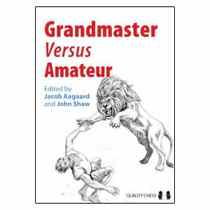Grandmaster versus Amateur
Jacob Aagaard

Grandmaster versus Amateur is something new and exciting. GMs Pavel Eljanov, Boris Avrukh, Mihail Marin, Peter Heine Nielsen, Tiger Hillarp Persson, Jacob Aagaard and John Shaw explain the many differences between Grandmasters and amateurs. This is not Euwes Chess Master vs. Chess Amateur revisited.
The back cover of this book reads:
“A multinational array of top grandmasters explains the differences in thinking between professional and amateur chess players, and how the amateur can bridge the gap. It usually takes at least a decade of sustained effort for even the most talented player to reach the grandmaster level and though this book cannot guarantee to make the reader a grandmaster, it is certainly a healthy nudge in the right direction.
This reviewer would agree. Quality Chess has assembled an excellent group of Grandmasters to describe the differences between the elite and mortals. Anyone that has witnessed the first few rounds of American Swiss tournament knows the normal state of affairs. The GM gets an edge from the opening and steadily and remorselessly increases it until the amateur cries uncle. Sometimes things are not so easy and the GM has to grind away using his superior tool set better positional understanding and vastly superior endgame play. Once in a blue moon the amateur bites the GM and draws blood.
The seven authors in eight chapters (Aagaard wrote two) present games from different angles. Sometimes they were at the beginning of their career facing the GM, later they were in the opposite situation.
Certainly advice on how to beat GMs is interesting, but far more useful for most will be the way the authors dissect typical mistakes made by amateurs. This is very instructive stuff. By the way the amateurs are not weak players. They are often 2200 or 2300 rated, in a few cases even stronger. The mistakes they make are not obvious.
Grandmaster versus Amateur is neither the lengthiest nor the most intense offering in the Quality Chess catalogue, but with its combination of instructive and entertaining writing it might end up the most thoroughly read.
Highly Recommended
